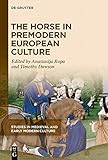The Horse in Premodern European Culture / ed. by Anastasija Ropa, Timothy Dawson.
Material type: TextSeries: Studies in Medieval and Early Modern Culture ; 70Publisher: Kalamazoo, MI : Medieval Institute Publications, [2020]Copyright date: ©2020Description: 1 online resource (VI, 259 p.)Content type:
TextSeries: Studies in Medieval and Early Modern Culture ; 70Publisher: Kalamazoo, MI : Medieval Institute Publications, [2020]Copyright date: ©2020Description: 1 online resource (VI, 259 p.)Content type: - 9781501518188
- 9781501514012
- 9781501513787
- 630.9 22
- SF284.E85 H67 2019
- online - DeGruyter
- Issued also in print.
| Item type | Current library | Call number | URL | Status | Notes | Barcode | |
|---|---|---|---|---|---|---|---|
 eBook
eBook
|
Biblioteca "Angelicum" Pont. Univ. S.Tommaso d'Aquino Nuvola online | online - DeGruyter (Browse shelf(Opens below)) | Online access | Not for loan (Accesso limitato) | Accesso per gli utenti autorizzati / Access for authorized users | (dgr)9781501513787 |
Frontmatter -- Contents -- Introduction -- Part I: Working Horses and Their Equipment -- 1. Equestrian Cities: The Use of Riding Horses and Characteristics of Horse Husbandry in Late Medieval Urban Agglomerations -- 2. Working Horses in the Northern European Countryside between the Thirteenth and Sixteenth Centuries: What Advantage for a Farm? -- 3. Baggage Animals – The Neglected Equines. An Introductory Survey of Their Varieties, Uses, and Equipping -- 4. Medieval Horse Harness – The Evidence of the Images -- Part II: Warhorses -- 5. Mounted Combat in Transition: The Transformation of the Eleventh Century -- 6. The Use of the Crossbow in Medieval Cavalry -- Part III: Performing Horses -- 7. Reading Horses and Writing Chivalry -- 8. How to Ride before a Prince: The Rise of Riding as a Performance Art -- Part IV: Caring for Horses -- 9. How to Make a White Mark on a Black Horse: Middle English Hippiatric Medicine, Common Diseases, and Their Remedies -- 10. Bread for My Horses -- Part V: Material Cultures of Riding -- 11. Curbing Horsepower: The Archaeology of Curb Bits in Medieval England – and Elsewhere -- 12. An Autopsy of Renaissance Equestrianism: The Materials, Making, and Use of a ca. 1535 War Saddle from the Musée des Beaux-Arts of Rennes -- Part VI: The Represented Horse: Law, Administration, and Literature -- 13. The Horse in Welsh and Anglo-Saxon Law -- 14. The Price and Value of the Warhorse in Late Medieval England -- 15. The (Galloway) Horse and His Boy: Le Roman Des Aventures De Fregus and “The Best Breed in the North”? -- Index of Personal Name -- Index of Place -- General Index
restricted access online access with authorization star
http://purl.org/coar/access_right/c_16ec
This volume provides a unique introduction to the most topical issues, advances, and challenges in medieval horse history. Medievalists who have a long-standing interest in horse history, as well as those seeking to widen their understanding of horses in medieval society will find here informed and comprehensive treatment of chapters from disciplines as diverse as archaeology, legal, economic and military history, urban and rural history, art and literature. The themes range from case studies of saddles and bridles, to hippiatric treatises, to the medieval origins of dressage literary studies. It shows the ubiquitous – and often ambiguous – role of the horse in medieval culture, where it was simultaneously a treasured animal and a means of transport, a military machine and a loyal companion. The contributors, many of whom have practical knowledge of horses, are drawn from established and budding scholars working in their areas of expertise.
Issued also in print.
Mode of access: Internet via World Wide Web.
In English.
Description based on online resource; title from PDF title page (publisher's Web site, viewed 28. Feb 2023)


